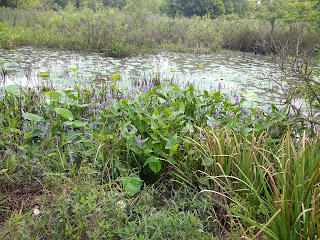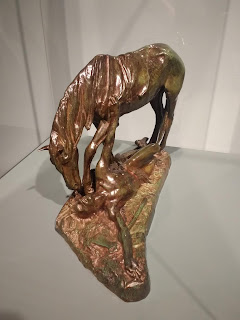After driving for almost 500 miles from Memphis on our very circuitous route home to Denver, we stopped for two nights in Tulsa, Oklahoma. The city is far enough out of the way of the nation's interstate system and also virtually only accessible via a toll road that we'd never visited it before on the way to or from our summer escape in Florida.
It was so relaxing after being cooped up in the car to go hiking at the city's Oxley Nature Center. I'd never heard of a Button Bush before - does anyone know whether its unusual flowers are unique to warmer climates than what we have here in Denver?
Beads: I read that since ancient times Native Americans have traded with both neighboring tribes and distant groups. By the mid-1800s, Plains Indian peoples participated in a global exchange, trading European products such as glass beads, colored cloth and iron tools for hides and pelts along well-established Native trade routes.
One of the most riveting museum exhibits I can remember seeing in a long time was The Gilcrease's titled Pulitzer Prize Photographs. The next time you look at a photo, think of this: "If it makes you laugh, if it makes you cry, if it rips out your heart, that's a good picture."
The exhibit's curator defined the power of the photos in a way I never could: "With the click of a button, photographers record the defining moments of our world and our time. The ugliness of war. The pain of poverty. The ecstasy of of victory. The triumph of redemption."
"The artist's songs celebrated the beauty and bounty of the United States; he spoke for people who had come upon hard times and his words gave a voice to their struggle, and his songs gave them hope and strength." The Center, also home to to the Woody Guthrie Archives, was a repository for his writings, art and songs.
Next post: Heading west on Historic Route 66!
Posted on August 22nd, 2019, from our home in Denver.
It was so relaxing after being cooped up in the car to go hiking at the city's Oxley Nature Center. I'd never heard of a Button Bush before - does anyone know whether its unusual flowers are unique to warmer climates than what we have here in Denver?
There had been a huge amount of flooding in Tulsa lately so some of the trails were pretty soggy and others impassable. The rain had also meant there were few people out birding or simply enjoying the walk. I was fortunate that we came across a woman who told us this was a Yellow Crowned Night Heron as we would have had no idea otherwise.
Probably because we were so quiet, the deer stood stock still for the longest time just staring at us!
A bird blind for spotting the birds in the pond beyond it:
Blackbird Marsh:
From the nature center, we drove to Oral Roberts University where this mammoth pair of Praying Hands greeted us at the entrance.
When Steven had done some research on Trip Advisor on Tulsa's sights, he found out about The Golden Digger which was the symbol of the International Petroleum Exhibition. The 1966 statue was "dedicated to the men of the petroleum industry who, by their vision and daring, have created from God's abundance a better life for mankind."
Long-term readers of the blog know how Steven and I always gravitate to art museums when we travel. That was why we headed to the Gilcrease Museum of Art named after the collector who acquired both historic American art as well as works by living artists. He was particularly interested in works from the Southwest US.
Steven paid special attention to this painting called Grand Canyon by William Leigh as he and our two sons would be hiking down to the canyon' bottom one day and then back up the following day in just a few days.
We could almost feel the wind and water churn in Winslow Homer's Watching the Breakers:
A Sioux Bison Effigy Pipe!
There were some stunning Mexican masks in the museum but my photos didn't turn out well enough to include here - drat!
Because they were compact and easily transported, beads made in Venice, Italy and Bohemia were important early trade items. Plains tribes developed preferences for particular bead colors and used them to create dazzling designs. Beadworking continues to be an important part of Native American art, culture, and business in the 21st century.
Bronzes by Frederic Remington:
Before Gutzon Borglum created Mount Rushmore National Monument in South Dakota, he was a noted bronze sculptor. His first work, Fallen Warrior, was exhibited at the 1891 Champs-de-Mars Salon in Paris. It was seen as a "metaphor for the American conquest and dominance of the continent and its original inhabitants."
These were but a few of the dozen pastel self-portraits by Bob Dylan in his Face Value and Beyond exhibit. The works premiered at London's National Portrait Gallery in 2013 and had only been shown once briefly in the US in 2013. The portraits and memorabilia of the Nobel Prize for Literature-winning artist were a small part of what will become the Bob Dylan Center that will open in Tulsa in 2021.
After seeing a few birds at the nature center that morning, I was more curious than I'd have been otherwise these paintings by John James Audubon who, I was surprised to find out, was born in Haiti as he's always referred to as being an American.
One of the most riveting museum exhibits I can remember seeing in a long time was The Gilcrease's titled Pulitzer Prize Photographs. The next time you look at a photo, think of this: "If it makes you laugh, if it makes you cry, if it rips out your heart, that's a good picture."
The exhibit's curator defined the power of the photos in a way I never could: "With the click of a button, photographers record the defining moments of our world and our time. The ugliness of war. The pain of poverty. The ecstasy of of victory. The triumph of redemption."
The museum's traveling exhibit featured the most comprehensive collection of Pulitzer-prize winning photographs ever assembled. The images represented every Pulitzer Prize Photography winner since 1942 and were named for 19th century newspaper editor and publisher Joseph Pulitzer who established prizes also for excellence in journalism, literature, music and drama.
These images had so touched my soul I remembered each as clear as day even though I hadn't seen most of them for years.
From the searing images, we took a much needed emotional break and drove to the Woody Guthrie Center downtown. Guthrie was one of America's greatest folksingers and most influential songwriters. Although born in Oklahoma, Guthrie's home was all of America - "from California to the New York island" as he wrote in his most famous song, "This land is Your Land."
If you're a music fan and ever find yourself anywhere close to Tulsa, go to the Guthrie Center as you'll have a great time listening to Guthrie's lyrics and finding out what a creative genius he was.
Posted on August 22nd, 2019, from our home in Denver.












































The button bush can live in CO, but, it likes it wetter to bloom good. Janina
ReplyDeleteThanks for letting me know that we shouldn't be adding the button bush to our new landscape, Janina!
ReplyDelete